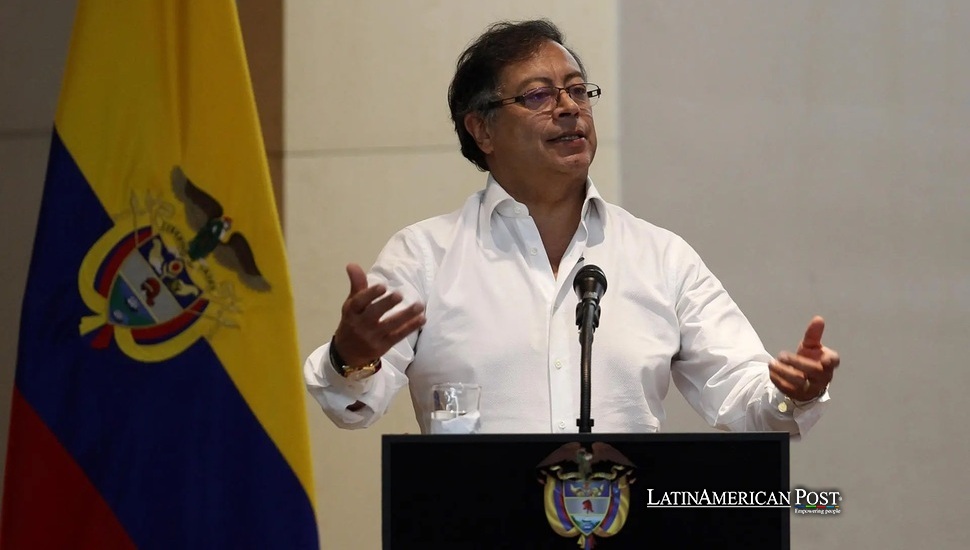Colombian Pink Tide Falters as Petro’s Government Crumbles

Colombia stands at a crossroads, its once-hopeful pink tide threatened by leadership turmoil and continuous ministerial exits. As President Gustavo Petro tried to steady his government, the more enormous leftist wave across Latin America encountered a challenge that cast doubt on its future.
Defining the Pink Tide and Its Legacy
To understand why Colombia’s current political storm signals a waning pink tide, it is vital to explore what the term “pink tide” actually means. During the 2000s and early 2010s, several Latin American countries chose left-leaning governments that said they would lower huge inequalities, oppose long-standing power groups, and boost social welfare. People called these governments “pink” instead of “red” to show they were not wholly socialist or communist, though they backed firm progressive plans. Leaders in countries like Venezuela, Brazil, Argentina, and Bolivia pushed government projects to lift poor communities, widen healthcare and education, and change how nations work independently.
Over time, however, this movement suffered severe setbacks. While many pink tide governments made initial gains—particularly in reducing poverty—allegations of corruption and damaging economic blunders tarnished the reputations of numerous leaders. In nations like Brazil, public anger at scandals eventually fueled the rise of right-wing contenders who promised stricter fiscal discipline, law and order, and a break from the turbulence that came to characterize particular leftist administrations. During this ebbing of the initial wave, observers began to wonder if the so-called pink tide was simply a fleeting historical phase.
Yet political currents in Latin America rarely follow a neat, linear trajectory. After several years dominated by conservative voices, a “new pink tide” appeared to surge again, symbolized by the election of leaders like Gustavo Petro in Colombia, Gabriel Boric in Chile, and the return of Luiz Inácio Lula da Silva in Brazil. Their rise brought back talk about whether leftist unity might grow again, like the early days of the first pink tide. Instead of the old mistakes, these figures promised a milder position plus updated policies. For example, he said he would shift Colombia’s economy from oil, change its security system, and start his feminist foreign policy. The aim was for new progressivism to avoid corruption and reduce waste next to offer a fair view of the region.
In Colombia, however, signs now show that the promise of change fades fast. Petro’s government now posts fewer victories but sees more cabinet shifts and divisive picks amid overall disorder. Recent cabinet resignations may be typical in a leadership environment that expects some turnover. Still, the pace and intensity of changes under Petro have undermined any illusion of stability or cohesion.
Petro’s Government Under Constant Strain
The sudden exit of four cabinet ministers over two weeks is not just a tiny error in Colombia’s political schedule; it shows real problems in government. Although Petro himself replaced over 40 ministers in two and a half years, this most recent set of resignations involves significant figures. Among those leaving are people in charge of environmental policy and national defense, two fields Petro promoted as key to Colombia’s change and as examples of the region’s broader leftist plan.
The effects on Petro’s government are extensive. On one level, losing key ministers handicaps the government’s ability to implement initiatives—whether green economic investments, negotiations with guerrilla groups, or new strategies to handle national security challenges. On another level, the turmoil calls into question Petro’s capacity to manage his political base. High-profile exits make headlines in Colombia and affect Latin America. They weaken the idea of a renewed pink tide rooted in shared leadership with firm values.
Some strain comes from Petro’s leadership. Critics say it acts too fast and shows too much dispute. Some observers describe him as stubborn, unwilling to compromise, and prone to making unilateral decisions alienating allies and potential partners. For example, tension with private industry groups creates stumbling blocks for attracting the kind of green investment Petro claims to champion. His methods of publicly reprimanding ministers demanding total cabinet resignations and then traveling abroad at crucial moments have added to a leadership environment full of uncertainty.
Petro’s selection of disputed figures adds to the sense of chaos. Choosing Armando Benedetti – accused of corruption and violence against women – as chief of staff upset group members.
Supporters expected an administration that showed clear ethics, respected women’s rights, or kept the government open. Yet raising Benedetti goes against these rules. Added to Petro’s public attacks on senior officials and his demand for their exit, the government seems to lose strength each time a new crisis appears. What was once advertised as an honest try to build a fairer Colombia now seems like a constant change of ministers hidden by messy management.
Leadership Missteps and Policy Drift
The cracks in Petro’s government are even more alarming when one considers his broader policy commitments. Shortly after he took office, he promised to pull Colombia away from oil reliance, a bold aim in a country where the energy sector has long served as a mainstay. While former Environment Minister Susana Muhamad began a green shift, key ministers left, which puts these projects at risk. Local and foreign investors require steady guidance and trust in government stability before they fund major green projects. Frequent minister changes cause uncertainty, making it hard for promising plans to begin.
Security is another area where Petro’s errors affect his political future more than his own. He initially pursued non-militarized solutions to Colombia’s decades-long conflict by negotiating cease-fires with rural guerrilla groups. For a short while, this gave many Colombians hope that the country might finally address chronic violence in a more constructive, less armed manner. Yet those aspirations have stumbled in the face of Petro’s administrative maneuvering. Talks with the National Liberation Army ended, causing fresh waves of displacement and violence near Colombia’s border with Venezuela. With no steady leadership at the defense ministry, large parts of the country stay at risk of conflict, which weakens Petro’s reputation as a president who seeks peace.
Petro’s embrace of a feminist foreign policy was another high-profile pledge that momentarily set him apart from previous Colombian administrations. While certain feminist and civil society groups gained traction within government structures, the choice of Benedetti as chief of staff undermines that progress. Critics say the choice, and Petro’s sometimes tricky way of making policies show a gap between words and reality. The promise of a “new left” that cares about women’s rights and holds institutions accountable now seems empty, adding to the frustration among Petro’s critics and those who helped him take power.
Observers in Colombia and abroad also look at developments in other Latin American countries to gauge whether Petro’s travails signify a broader pink tide retreat. Chile’s President Gabriel Boric faced a significant setback when his attempt to pass a progressive constitution failed, diminishing his political capital. In Brazil, Lula da Silva has returned to the presidency but wrestles with growing dissatisfaction that counters the lofty popularity he once enjoyed. Although a few left-wing leaders remain relatively popular in the region, the string of misfires in places like Colombia and Chile signals that the second pink tide might be unsteady at best and short-lived at worst.
Colombia’s Turning Point and a Waning Tide
Colombia’s experience under Petro shows that a pink tide comeback cannot rely only on lofty aims and popular views. Without unified management or fixed ethical standards, the surge that brought Petro to office may crash on the hard coast of public disappointment. The exit of top officials, an uneven policy approach, or the naming of dubious partners create instability. Promises to tackle climate change, revise security, or improve women’s rights lose impact amid administrative shakeups and fading public trust.
Voters already show that unrest could cause large political losses. Early polls before Colombia’s 2026 presidential election indicate a right-wing candidate in the lead—a sharp change for a country that recently picked a leftist leader for the first time in modern history. Suppose Petro cannot regain control of his cabinet and restore faith in his leadership. In that case, the electorate may decide that Colombia’s experiment with a bold new era of progressive governance is simply unviable.
The broader regional implication is stark: if a high-profile figure like Petro, part of the vanguard of the new pink tide, cannot demonstrate effective governance, skepticism will deepen across Latin America. The wave that once carried hope for a more united, equitable region might dissipate faster than anyone anticipated, leaving a lingering question of whether the vision was ever attainable without fundamental structural reforms and more adept leadership.
The tragedy is that many policy goals tied to the pink tide remain urgent for a country like Colombia. Rampant inequality and environmental peril, along with entrenched violence, need bold fixes. Such fixes require skill and openness next to solid political backing. Petro’s government, marred by frequent minister changes and a series of quick choices, does not show the steadiness required to guide lasting change. Until the administration confronts its lack of unity, the pink tide in Colombia may collapse under its contradictions, taking with it the hopes of those who yearned to transform national priorities.
Also Read: Colombia’s Petro Controversial Claims Spark Cocaine – Alcohol Comparison Debate
As Petro’s government unravels, the rest of Latin America watches closely. If Colombia’s pink tide collapses soon, it may be a sign of a rollback of leftist government across the region. But the point goes further than left or right labels. It shows that leaders count. Any government that wants to make significant changes must build a strong team, maintain trust, and meet its moral promises. Its high goals stick to empty promises instead of turning into actual policies that help people. If the pink tide goes back, it might bring a conservative turn. However, in a nation where social and economic inequalities persist, the real test will be whether any future government can move beyond political spectacle to address the structural problems that have long hampered Colombia’s growth. For now, the flame of Colombia’s pink tide appears to flicker, diminished by chaotic leadership and the disillusionment of a public that expected something better than the turmoil it currently endures.





